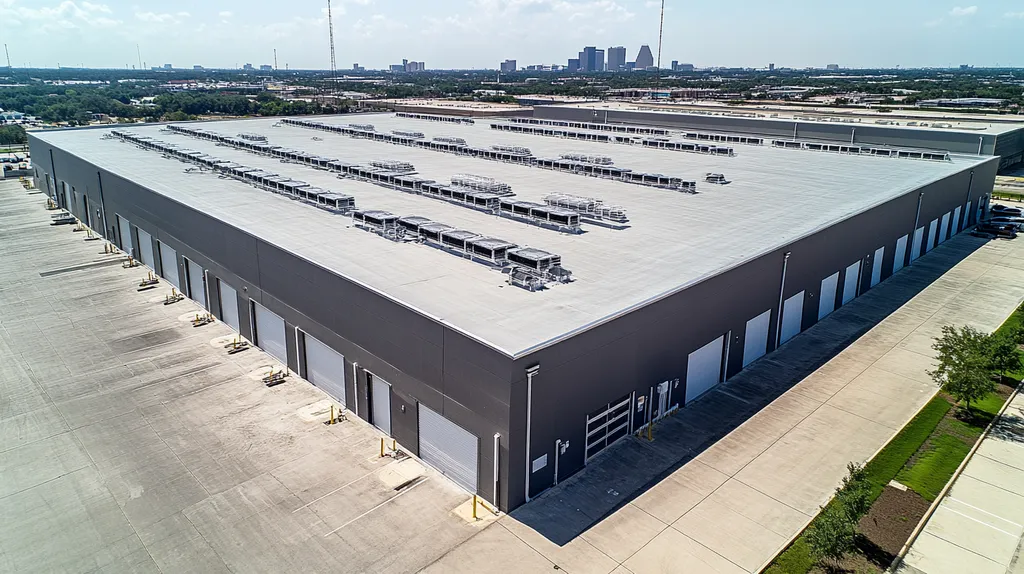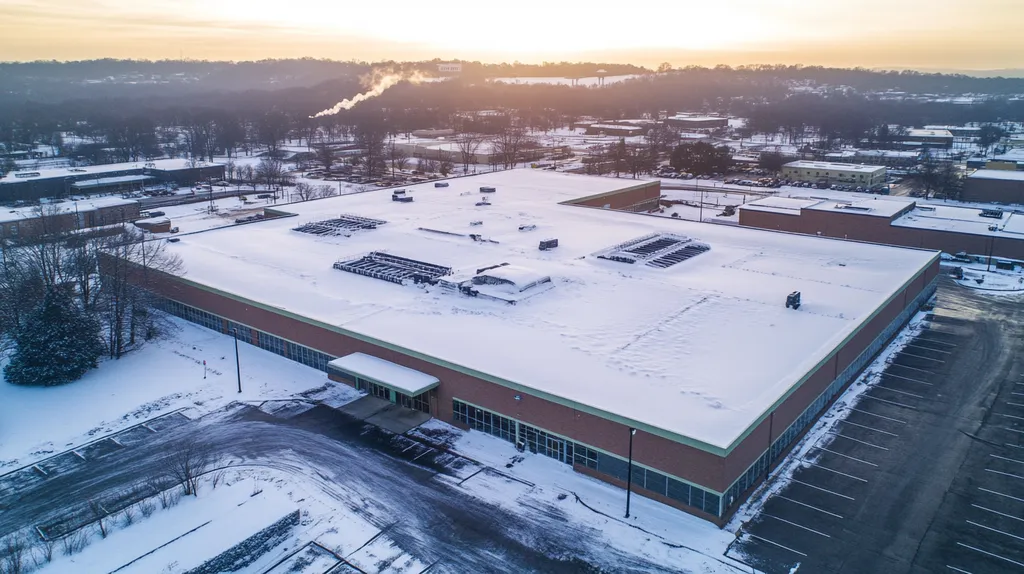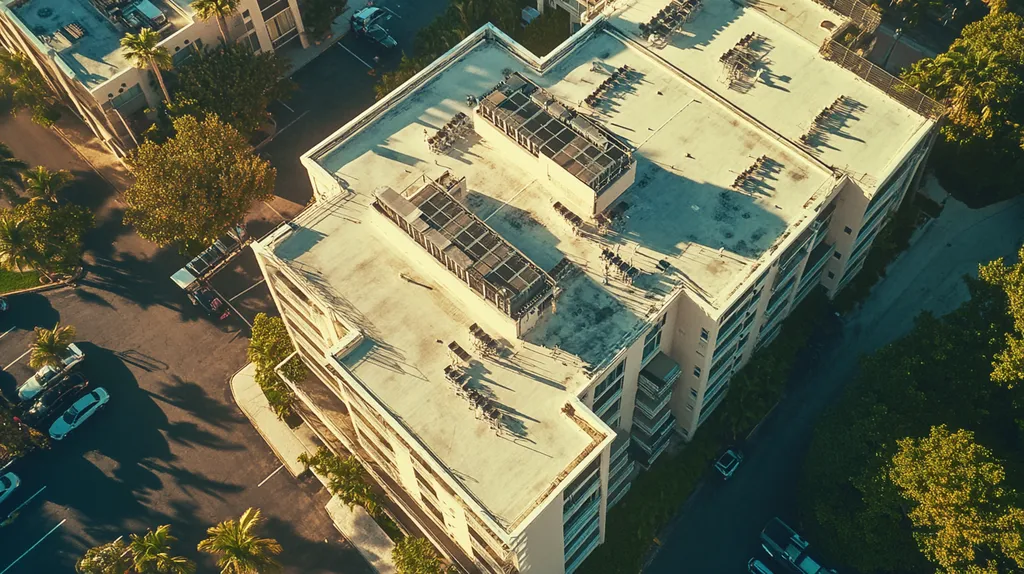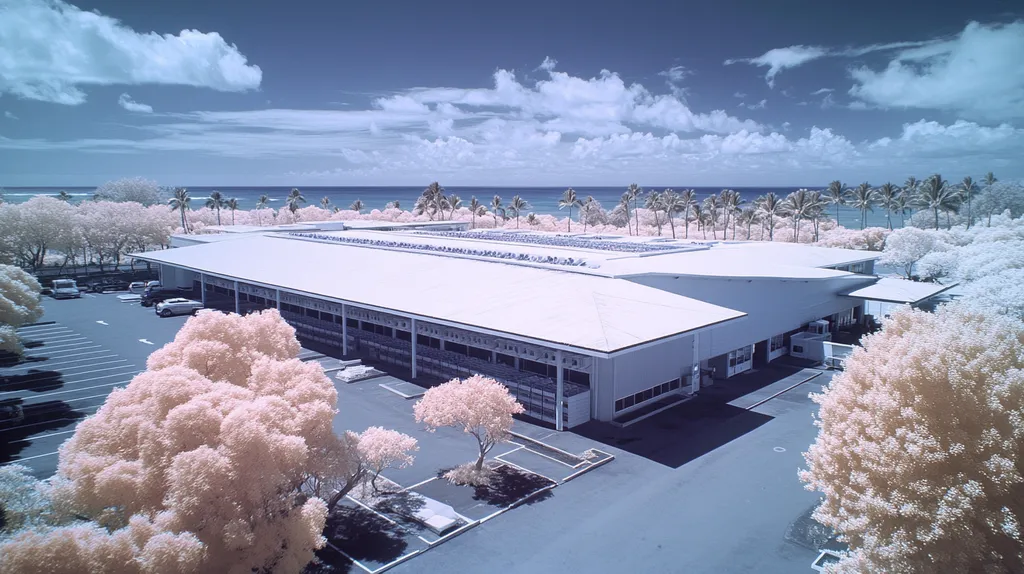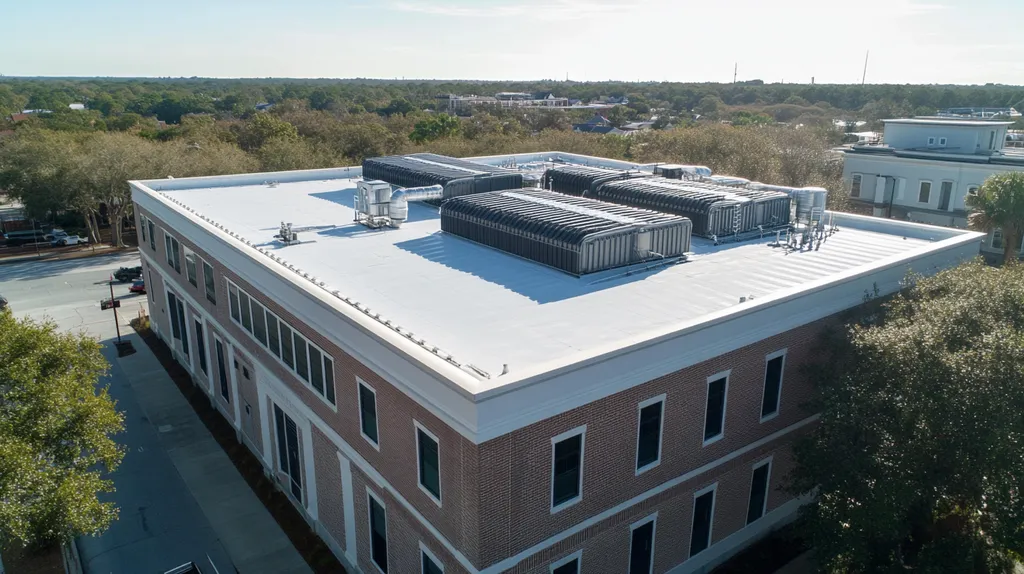In industrial roofing, faulty ventilation practices are silently sabotaging facilities across America, with the Department of Energy reporting a staggering 30% increase in energy costs due to inadequate airflow systems.
From moisture-trapped membranes deteriorating years before their time to mold infestations that trigger costly remediation, the consequences of outdated ventilation approaches are impossible to ignore.
This analysis challenges conventional wisdom around industrial roof ventilation, examining how established practices fall short and exploring data-driven solutions that promise better outcomes for facility managers.
SECTION 1: CURRENT PRACTICES
Effective ventilation is crucial during maintenance and repair work to ensure the efficiency and longevity of an industrial roof. When ventilation is inadequate, it can trigger a chain reaction of problems, including moisture build-up, mold growth, and structural deterioration. These issues can leave property owners with repair bills that feel like they’re straight out of a horror movie. Recognizing the shortcomings of current ventilation practices is essential, as many facilities may be relying on outdated methods that threaten their roof’s integrity and overall performance.
Standard Ventilation Calculations
Getting ventilation calculations right is fundamental for any industrial roof to properly expel heat and moisture. The common go-to here is the ACH (Air Changes per Hour) formula, which requires accurate inputs like building volume and occupancy levels. Yet, many property owners neglect these calculations, leaving their spaces under-ventilated and prone to irreparable damage.
Consider older facilities that still cling to outdated ACH standards; they might be setting themselves up for failure with insufficient airflow. And don’t forget recent expansions or renovations—if those aren’t factored into ventilation plans, problems are bound to arise. Keeping these calculations current is vital for maintaining roof performance and safeguarding investments.
To enhance outcomes, facility managers should routinely assess airflow demands and adjust their calculations. Modern software tools make it easier than ever to conduct these assessments accurately, enabling more informed decisions.
Ultimately, updating ventilation calculations not only boosts energy efficiency but also significantly lowers the risk of damage—underlining their importance in industrial roofing.
Common Ventilation Components
Successful industrial roof ventilation depends on several key components, including exhaust fans, intake vents, and ridge vents. Exhaust systems kick out heated air, while intake vents invite in cooler air to circulate throughout the building. Their installation and ongoing maintenance are crucial for achieving optimal performance.
It’s too common for facilities to rely solely on passive ventilation systems. But when the temperature climbs or humidity rises, these systems can fall flat, leading to heat retention that harms roofing materials and structures alike.
Active ventilation systems may carry a higher price tag, but they offer a dependable solution by consistently moving air throughout the space. This proactive approach effectively curbs heat build-up and moisture retention, greatly enhancing the longevity of roofing materials.
Property owners need to carefully weigh the costs and benefits of different ventilation components to choose systems that align with their unique environmental challenges. A well-configured ventilation setup not only protects the structure but also significantly boosts indoor air quality.
Code Compliance Requirements
Adhering to code compliance is essential in the world of industrial roofing ventilation. Local building codes establish minimum ventilation requirements designed to shield structures from damage. Many property owners, however, stop at these baseline standards without considering the specific needs of their buildings.
Take a facility that technically meets code but suffers from unique challenges—like high moisture levels or excessive heat from production activities. Without going beyond the compliance checklist, these nuanced issues might continue to wreak havoc on the roof.
Enlisting qualified professionals can help property owners navigate the complex landscape of building codes and their implications for ventilation. These experts can offer insight into how codes impact operations and suggest tailored improvements.
Overlooking proper ventilation not only invites potential non-compliance but also risks prolonging repair times and inflating costs. By placing ventilation at the forefront of industrial roofing considerations, property owners can foster better outcomes for their facilities.
SECTION 2: SYSTEMIC ISSUES
In the world of industrial roofing, failing to ensure proper ventilation is like tossing a lit match into a barrel of oil—disastrous consequences await. Trapped moisture can wreak havoc on building integrity, leading to water intrusion that brings along costly repairs and annoying operational disruptions. On top of that, poor ventilation can drain energy efficiency, hitting both financial resources and our planet hard. This section dives into the critical risks of moisture accumulation, the energy efficiency shortfalls experienced, and the maintenance gaps that sprout from outdated rooftop practices.
Moisture Accumulation Risks
When it comes to roofing work, moisture accumulation isn’t just a minor irritation; it’s a ticking time bomb. Insufficient ventilation traps humidity beneath the roof layer, creating a cozy home for mold and mildew. Research shows that these moisture-related issues can cause a staggering 20% reduction in roof lifespan, skyrocketing replacement costs.
But the damage doesn’t stop there. That pesky trapped moisture can invade insulation and decking, jeopardizing the very structure of the building. Weakening structures may end up calling for extensive repairs, inducing headaches and downtime for businesses. Unfortunately, many property owners remain blissfully unaware of how inadequate ventilation directly fuels these problems—until it’s too late, of course.
Adopting effective ventilation strategies during roofing work can significantly mitigate these moisture damage risks. Keeping materials dry not only cuts down on maintenance expenses but also staves off additional complications. For property owners eager to boost their roofing practices, understanding these risks is vital.
Energy Efficiency Shortfalls
Poor ventilation isn’t just a nuisance; it also robs buildings of energy efficiency. Without adequate airflow, buildings may suffer from overheating, resulting in increased reliance on air conditioning. The U.S. Department of Energy has pointed out that improper ventilation can pump up energy costs by as much as 30%—that’s a hefty price for being under-ventilated.
This inefficiency isn’t just a financial drag; it carries environmental baggage as well. Elevated energy consumption contributes to larger carbon footprints, hampering the sustainability goals many businesses set for themselves. Ventilation can’t be an afterthought; it’s time to reevaluate its role in effective energy management.
By upgrading roofing ventilation systems, companies can enhance energy efficiency and uphold their sustainability commitments. Implementing ventilation solutions that facilitate better airflow can yield significant savings on operational costs and minimize environmental impact.
Maintenance and Inspection Gaps
Let’s face it: maintenance practices for ventilation systems during industrial roofing work often take a backseat. Without routine inspections, unseen flaws can fester and explode into major issues down the road. Nearly 50% of roof-related claims arise from inadequate maintenance, highlighting the pressing need for a proactive strategy.
Many property owners mistakenly believe that once roofing work is completed, the system will magically function optimally. Spoiler alert: that’s not how it works. This misconception can precipitate a rapid decline in condition, making way for significant repairs down the line. Establishing regular inspection protocols is key to catching ventilation inefficiencies early.
Incorporating consistent maintenance measures ensures that the roofing system performs effectively throughout its lifespan. By prioritizing these practices, property owners not only protect their investment but also avoid a cascade of future issues. A shift towards a proactive mindset in inspection and maintenance is essential for maintaining robust roofing systems.
SECTION 3: MISSED OPPORTUNITIES
The industrial roofing sector often turns a blind eye to specific ventilation needs, and the fallout can be steep. According to the U.S. Department of Energy, poor roof ventilation can inflate energy costs by an astonishing 30%. This section highlights critical areas where valuable opportunities are missed, including the neglect of climate adaptation, oversight of design variations, and the failure to integrate insulation effectively.
Overlooking Climate-Specific Needs
When it comes to roofing ventilation, following generic guidelines often disregards the distinct climate conditions of a location. For instance, facilities in humid regions require tailored ventilation approaches that differ significantly from those in dry areas.
Ineffective adaptations to local weather can spell disaster, as trapped moisture becomes a hotbed for mold and rotting structures. These issues can result in pricey repairs and a shortened lifespan for the roofing system.
In icy climates, inadequate ventilation can lead to ice damming, stressing the roof and risking structural integrity. Customizing ventilation solutions based on climate needs is essential for optimizing roof performance and longevity.
Investing in climate-specific ventilation strategies not only enhances effectiveness but can also lead to notable savings in maintenance and energy costs, ultimately boosting the value of the property.
Ignoring Building Design Variations
No two industrial buildings are the same; each has its own architectural and functional quirks that influence ventilation requirements. Standard cookie-cutter practices can often fall flat, leading to inadequate ventilation strategies.
Take buildings with soaring ceilings or intricate layouts—these structures need specialized ventilation designs to ensure air distributes evenly. Ignoring these architectural variations can create areas of stagnant air or excessive heat, impacting the work environment.
Additionally, facilities housing machinery that emits fumes require extra ventilation considerations for health and safety. Overlooking these specifics not only risks compliance issues but can also hinder employee productivity.
By acknowledging the unique features of their buildings, property owners can implement ventilation solutions that enhance safety, efficiency, and overall roofing performance.
Neglecting Synergy with Insulation
A frequent oversight in industrial roofing is the lack of integration between ventilation and insulation systems. Properly aligned insulation and ventilation are essential for regulating temperatures and ensuring energy efficiency.
Without this synergy, thermal imbalances can lead to increased energy bills and discomfort for occupants. For example, poorly insulated roofs can exacerbate condensation issues, complicating ventilation efforts even further.
Ensuring that insulation methods and ventilation systems work hand-in-hand allows property owners to optimize energy usage, mitigating heat loss or gain effectively. This concerted effort can also prevent long-term damage to roofing infrastructure.
Addressing this often-ignored opportunity enhances building performance, promotes energy savings, and significantly improves occupant comfort and safety.
SECTION 4: ROOT CAUSES
Ineffective ventilation during industrial roofing projects can spell disaster. Structural damage, health hazards, and skyrocketing energy bills are just some of the consequences of ignoring this critical aspect. According to studies, poor ventilation practices can account for a staggering 30% of energy costs in industrial buildings. It’s essential for property owners and facility managers to get to the bottom of ventilation failures to avoid costly pitfalls. The subsections ahead dive into the heart of the matter: inadequate assessment of ventilation needs, poor installation and balance of vents, and lack of regular maintenance.
Inadequate Assessment of Ventilation Needs
A haphazard approach often initiates industrial roofing projects, with many skipping a thorough assessment of ventilation requirements. Property owners frequently ignore pivotal factors such as building size, usage patterns, and local climate when planning ventilation solutions. This oversight can create a suffocating atmosphere, trapping heat and moisture inside the building.
The fallout from inadequate assessment is dire: mold and mildew can flourish, compromising the structural integrity and posing health risks for workers. Additionally, energy efficiency takes a nosedive when ventilation isn’t tailored to specific needs, making HVAC systems work overtime. This can lead to operational costs spiraling out of control.
A solid investment in comprehensive evaluations can tackle immediate ventilation issues while ensuring long-term sustainability. Involving ventilation experts can illuminate unique needs that disrupt standard practices, leading to better outcomes and fewer headaches down the line.
Ultimately, neglecting thorough assessments puts facilities at risk and underscores the need for vigilant planning and evaluation before launching roofing projects.
Poor Installation and Balance of Vents
The installation phase is where many vital decisions are made about optimal ventilation. Misplacement or poor calibration of vents can wreak havoc, obstructing airflow and creating stagnant zones. In far too many cases, contractors cut corners on installation, leading to uneven temperatures and humidity throughout the facility.
When vent systems aren’t calibrated accurately, some areas may experience over-ventilation while others remain trapped in stillness. This imbalance spikes discomfort levels and can accelerate wear on machinery, driving up energy costs. Over-ventilation during colder months can even lead to unnecessary heat loss, making the situation worse.
Ensuring vents are installed according to established industry standards is a game-changer for overall performance. Advanced airflow simulation tools can help dictate the correct placement and sizing of vents, bolstering efficiency significantly. This step is essential for preserving the lifespan of the roofing system.
As the industry progresses, embracing best practices in vent installation is paramount for all participants. The priority should be striking a balance that caters specifically to each building’s unique requirements.
Lack of Regular Maintenance
Regular maintenance for ventilation systems tends to get pushed aside, leading to long-term systemic problems. Many facilities lack a formal maintenance program, resulting in neglected vents and clogged filters. This negligence creates an ideal breeding ground for mold, trapping heat and moisture.
Moreover, research indicates that improper maintenance can cut the lifespan of HVAC equipment significantly. As systems struggle to maintain efficiency, energy costs can soar, translating into budget overruns for facility managers.
Creating a schedule for check-ups and necessary repairs can alleviate these risks. Regular assessments empower property owners to tackle issues before they snowball into major headaches. Investing in maintenance safeguards not only the building but also the well-being of its occupants.
A culture of proactive maintenance is essential for optimizing ventilation. Prioritizing these practices fosters healthier indoor environments and enhances operational efficiency throughout the roofing system’s life cycle.
DATA DRIVEN EVIDENCE
In the world of industrial roofing, the stakes are high. Poor ventilation practices can set off a costly chain reaction that many property owners fail to see coming. A staggering study reveals that nearly 30% of commercial roofs face premature downfall due to inadequate ventilation. Let’s dig into eye-opening case studies, energy ramifications, and the long-term consequences on roof durability, underscoring the pressing need for a major standard makeover.
Case Studies on Ventilation Failures
Investigating real-world examples uncovers the heavy toll of neglecting proper ventilation. One striking case involves a Midwest manufacturing plant where improper roofing installation trapped moisture, wreaking havoc. The aftermath? A staggering $250,000 bill for repairs and lost productivity due to roof leaks and mold.
Similarly, a food processing facility experienced escalating energy costs from air quality issues linked to ventilation shortcomings. Such incidents illustrate that inadequate ventilation isn’t just a technical oversight; it translates directly into financial and operational chaos.
Beyond repairs, these ventilation failures often result in legal battles, as tenant disputes arise over dangerous living conditions. These examples serve as a stark reminder of the urgent need for better practices and adherence to ventilation standards in the industrial roofing sector.
Energy Consumption and Cost Analysis
Poor ventilation doesn’t just affect comfort; it sends energy costs skyrocketing. When airflow is insufficient, buildings heat up, causing HVAC systems to struggle. A study by the National Roofing Contractors Association revealed that inadequate ventilation can rocket energy costs up by 20%, a grim reality for property owners trying to stay competitive.
But don’t forget about the hidden savings! Investing in the right ventilation systems can save an average of 15% on energy bills within just a year. Ignoring these ventilation issues leads to unnecessary expenses that could easily be curbed with smart design and implementation.
In today’s cutthroat market, letting energy costs spiral is not just bad for the budget—it’s downright reckless. Prioritizing effective ventilation is not just a luxury; it’s essential for smart financial planning.
Impact on Roof Longevity and Durability
The longevity of a roof hinges on effective ventilation. Inadequate airflow accelerates thermal shock, triggering material fatigue and eventual failure. Studies demonstrate that well-ventilated roofs can last 25-30% longer than those trapped in stagnant air.
A report from the Cool Roofing Coalition reinforces this notion, stating that good ventilation minimizes moisture damage, extending the life of roofing materials significantly. In contrast, roofs neglected in this regard may require complete replacements in as little as a decade.
Investing in proper ventilation isn’t merely a choice; it’s a strategic move to safeguard the future of a building. Owners and facility managers who prioritize ventilation can expect tangible benefits that stretch far beyond initial costs, securing the structural integrity and longevity of their investments.
SECTION 6: ALTERNATIVE SOLUTIONS
As industrial roofing practices evolve, the tools and strategies for ensuring effective ventilation must step up as well. Ignoring solid ventilation leads to problems that can cripple a facility, like rampant mold growth and structural failure, racking up repair bills that have facility managers gasping for air. By exploring advanced technologies and tailored designs, property owners can boost both safety and the durability of their roofs. This section shines a light on innovative ventilation solutions that challenge the status quo and protect valuable assets.
Advanced Ventilation Technologies
New advancements in ventilation technologies are shaking up the industrial roofing scene. Smart systems equipped with sensors can monitor airflow and temperature, optimizing conditions in real time. This proactive approach significantly cuts down the chances of moisture buildup, a headache that’s often sidelined in traditional setups.
Consider systems that integrate with building automation for dynamic adjustments based on changing weather. With such systems, ventilation stays effective without any manual fuss—reducing the risk of roof-related headaches that can cause financial and operational turmoil.
Energy recovery ventilators (ERVs) take this a step further by enhancing air quality while slashing energy costs. By recycling energy from exhaust air, ERVs make it easier to maintain a comfortable indoor climate without breaking the bank.
Choosing advanced ventilation technologies is more than just a fix; it’s a strategic leap forward in roof management. Facilities adopting these systems often see increased property value and lower maintenance costs over time.
Customized Ventilation Designs
No two industrial facilities are the same—neither are their ventilation needs. Customized ventilation designs have emerged as an essential alternative to cookie-cutter solutions. By thoroughly evaluating specific layouts, operational processes, and environmental conditions, tailored systems can be crafted to maximize efficiency.
Take, for instance, facilities housing equipment that generates excessive heat; they might need pinpoint exhaust systems to tackle high-heat zones. These designs target specific hot spots, boosting worker comfort and preserving sensitive materials.
Plus, some systems allow for variable exhaust rates, adapting to roofing activities in real time. During peak operations, increased ventilation keeps air quality high, promoting a healthier working environment.
By opting for custom solutions, property owners can also sidestep the over-ventilation issues that waste energy and undermine heating effectiveness. Properly designed systems translate into better energy efficiency while maintaining health and safety standards.
Integrated Ventilation and Insulation Systems
Combining ventilation and insulation into cohesive systems offers a double-edged advantage that industrial roofing frequently overlooks. By synchronizing these crucial elements, facilities not only encourage better air movement but also significantly enhance thermal performance. This synergy can lead to superior climate control within the building.
For example, innovative composite insulation products with built-in ventilation channels create airflow pathways while delivering top-notch temperature regulation. This reduces potential condensation-related damage, addressing both air quality and structure integrity head-on.
Moreover, integrated systems can simplify installation, cutting labor costs and minimizing disruptions during roofing work. A unified approach to ventilation and insulation empowers property owners to optimize roof performance through a seamless design.
In conclusion, integrating ventilation and insulation systems is a savvy investment in the longevity and efficiency of facilities. Business owners who embrace such innovations stand to reap tangible returns, both financially and structurally, for years to come.
The Bottom Line
With industrial roofing failures costing U.S. businesses over $2.5 billion annually in repairs and energy waste, the industry can no longer afford to cling to outdated ventilation practices.
The evidence is clear: traditional approaches to roof ventilation are failing to address climate-specific challenges, ignoring crucial building variations, and missing opportunities for integration with modern insulation systems.
Data shows that facilities implementing advanced ventilation technologies and customized designs are seeing up to 40% longer roof lifespans and 30% reductions in energy costs.
The path forward demands a fundamental shift from one-size-fits-all solutions to data-driven, climate-adaptive ventilation strategies that protect both infrastructure investments and operational efficiency.
The stakes are simply too high to maintain the status quo.
FREQUENTLY ASKED QUESTIONS
Q. What are current ventilation practices for commercial roofs?
A. Current practices rely on outdated ACH calculations, leading to inadequate airflow. This can cause moisture buildup, resulting in costly damage and reduced roof lifespan. It’s essential for property owners to reassess their ventilation strategies regularly to maintain optimal roof performance.
Q. What systemic issues affect industrial roof ventilation?
A. Systemic issues include moisture accumulation and energy inefficiency. Many properties experience deteriorating conditions due to poor ventilation practices. Ignoring these problems can lead to expensive repairs and hinder overall building performance, emphasizing the need for proper ventilation management.
Q. Why are climate-specific needs important for industrial roofs?
A. Climate-specific needs prevent excessive moisture issues and ensure optimal temperature control. Generic guidelines often miss crucial factors like humidity and temperature variations. Tailored approaches mitigate risks like mold growth and structural failure, ultimately enhancing roof lifespan and efficiency.
Q. What root causes lead to ventilation failures?
A. Root causes often include inadequate assessment of ventilation needs and poor installation practices. Ignoring these factors can result in serious safety hazards and increased operational costs. Regular maintenance routines are essential to avert these common pitfalls in industrial roofing.
Q. How does poor ventilation affect energy costs?
A. Poor ventilation can escalate energy costs by up to 30%. Inadequate airflow causes HVAC systems to work harder, increasing energy consumption. This not only impacts budgets but also contributes to larger carbon footprints, necessitating a reevaluation of ventilation strategies.
Q. What alternative solutions exist for roof ventilation?
A. Alternative solutions include advanced technologies like smart ventilation systems and customized designs. Tailored ventilation approaches consider specific building layouts, improving energy efficiency and employee comfort. Integrating ventilation and insulation further promotes optimal climate control and long-term structural integrity.
Q. What downtime issues arise from poor ventilation practices?
A. Poor ventilation can lead to significant downtime due to equipment damage and safety hazards. If moisture traps cause structural issues, it results in interruptions to workflow and productivity. Prioritizing effective ventilation directly supports operational continuity and avoids costly delays.


